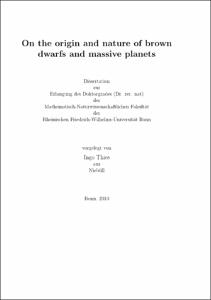Thies, Ingo: On the origin and nature of brown dwarfs and massive planets. - Bonn, 2011. - Dissertation, Rheinische Friedrich-Wilhelms-Universität Bonn.
Online-Ausgabe in bonndoc: https://nbn-resolving.org/urn:nbn:de:hbz:5N-24528
Online-Ausgabe in bonndoc: https://nbn-resolving.org/urn:nbn:de:hbz:5N-24528
@phdthesis{handle:20.500.11811/4946,
urn: https://nbn-resolving.org/urn:nbn:de:hbz:5N-24528,
author = {{Ingo Thies}},
title = {On the origin and nature of brown dwarfs and massive planets},
school = {Rheinische Friedrich-Wilhelms-Universität Bonn},
year = 2011,
month = mar,
note = {In this thesis the apparent peculiarities of brown dwarfs (BDs) are pointed out which force us to treat them as a population apart from, but yet still related to the stellar population. In particular, the properties that make BDs so special are deduced from the observational evidence in Chapter 1: 1. The brown dwarf desert, i.e. the apparent dearth of substellar, non-planetary companions to stars, 2. the truncated distribution of the semi-major axes of BD-BD binaries, 3. the unusually top-heavy mass ratio distribution of BD-BD binaries, compared to star-star binaries, and 4. the theoretical difficulties to explain a star-like, i.e. isolated formation scenario for BDs (Adams & Fatuzzo 1996; Goodwin & Whitworth 2007). These combined facts effectively rule out star-like formation as the predominant mechanism of BD formation. In addition, some fraction of very-low-mass stars may also have a non-star-like origin. As an immediate consequence, a separate population, here called BD-like, is introduced. Although the present observational data do not yet allow a precise determination of the mass range of this population, a steep descent of the BD-like initial mass function between 0.1 and 0.2 Msun as well as a steep onset of the stellar IMF slightly below the hydrogen-burning mass (0.075 Msun) appears to be in good agreement with the lower end of the observational mass function if it has been corrected for unresolved binaries. This two-populations model results necessarily in a discontinuity in the overall IMF of BDs and stars together. This discontinuity may be hidden in the observed mass function unless the mass function is corrected for unseen binaries. In Chapter 2 the issue is revised for the case of a high abundance of BD-BD binaries. It is shown that the discontinuity persists even if a star-like BD-BD binary fraction of up to 60% is assumed. This further supports the two-populations model. In Chapter 3 a probable formation scenario of BDs (as well as for massive gas planets) is presented. Earlier work by Stamatellos et al. (2007) and subsequent studies had shown that fragmentation of massive circumstellar disc beyond 100~AU is a valid mechanism to form substellar companions. My research now shows that less massive (and thus more frequent) discs can also fragment upon a tidal perturbation. While direct hydrodynamic perturbation in disc-disc collisions (Shen et al. 2010) requires two colliding massive discs, rendering such a scenario highly improbable, a tidal perturbation by a low-mass star with no disc or only a negligibly small disc (i.e. a typical protoplanetary disc in contrast to a massive extended one) appears to be reasonably probable for encounter distances around 500~AU, as estimated by Thies et al. (2005) and briefly revisited in Chapter 3.},
url = {https://hdl.handle.net/20.500.11811/4946}
}
urn: https://nbn-resolving.org/urn:nbn:de:hbz:5N-24528,
author = {{Ingo Thies}},
title = {On the origin and nature of brown dwarfs and massive planets},
school = {Rheinische Friedrich-Wilhelms-Universität Bonn},
year = 2011,
month = mar,
note = {In this thesis the apparent peculiarities of brown dwarfs (BDs) are pointed out which force us to treat them as a population apart from, but yet still related to the stellar population. In particular, the properties that make BDs so special are deduced from the observational evidence in Chapter 1: 1. The brown dwarf desert, i.e. the apparent dearth of substellar, non-planetary companions to stars, 2. the truncated distribution of the semi-major axes of BD-BD binaries, 3. the unusually top-heavy mass ratio distribution of BD-BD binaries, compared to star-star binaries, and 4. the theoretical difficulties to explain a star-like, i.e. isolated formation scenario for BDs (Adams & Fatuzzo 1996; Goodwin & Whitworth 2007). These combined facts effectively rule out star-like formation as the predominant mechanism of BD formation. In addition, some fraction of very-low-mass stars may also have a non-star-like origin. As an immediate consequence, a separate population, here called BD-like, is introduced. Although the present observational data do not yet allow a precise determination of the mass range of this population, a steep descent of the BD-like initial mass function between 0.1 and 0.2 Msun as well as a steep onset of the stellar IMF slightly below the hydrogen-burning mass (0.075 Msun) appears to be in good agreement with the lower end of the observational mass function if it has been corrected for unresolved binaries. This two-populations model results necessarily in a discontinuity in the overall IMF of BDs and stars together. This discontinuity may be hidden in the observed mass function unless the mass function is corrected for unseen binaries. In Chapter 2 the issue is revised for the case of a high abundance of BD-BD binaries. It is shown that the discontinuity persists even if a star-like BD-BD binary fraction of up to 60% is assumed. This further supports the two-populations model. In Chapter 3 a probable formation scenario of BDs (as well as for massive gas planets) is presented. Earlier work by Stamatellos et al. (2007) and subsequent studies had shown that fragmentation of massive circumstellar disc beyond 100~AU is a valid mechanism to form substellar companions. My research now shows that less massive (and thus more frequent) discs can also fragment upon a tidal perturbation. While direct hydrodynamic perturbation in disc-disc collisions (Shen et al. 2010) requires two colliding massive discs, rendering such a scenario highly improbable, a tidal perturbation by a low-mass star with no disc or only a negligibly small disc (i.e. a typical protoplanetary disc in contrast to a massive extended one) appears to be reasonably probable for encounter distances around 500~AU, as estimated by Thies et al. (2005) and briefly revisited in Chapter 3.},
url = {https://hdl.handle.net/20.500.11811/4946}
}






